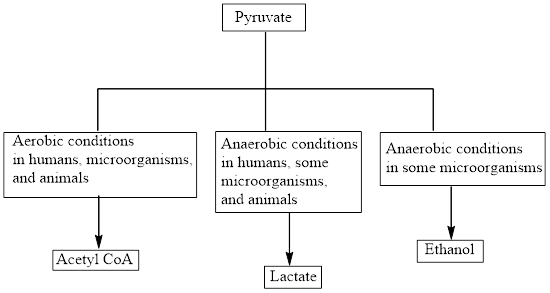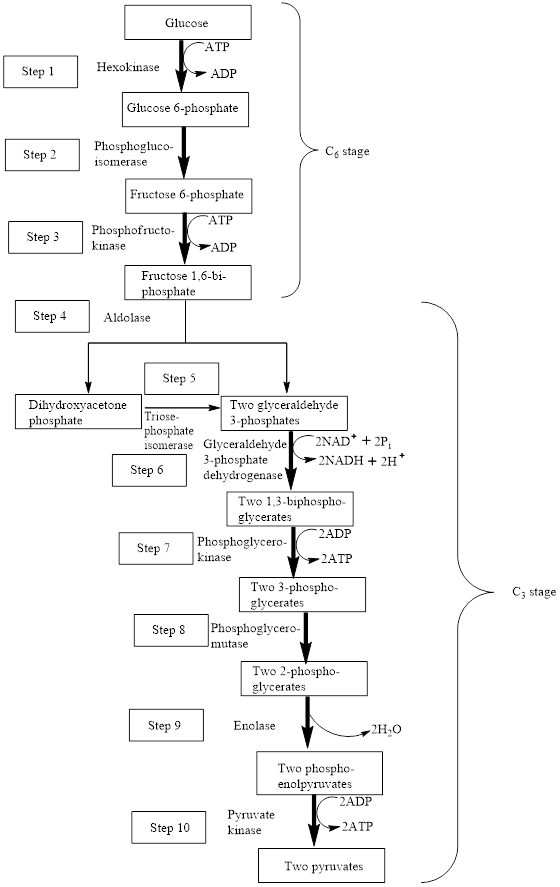
Concept explainers
(a)
Interpretation: To indicate whether
Concept introduction: In the glycolysis
Pyruvate is the end product in the glycolysis. The production of the fate of pyruvate varies with the nature of the organism and the cellular conditions. The three common fates of pyruvate are as follows:

(a)
Answer to Problem 13.47EP
Carbon dioxide
Explanation of Solution
Reason for correct option:
Under aerobic conditions, pyruvate is converted to

The overall reaction equation for the conversion of pyruvate to
The process of ethanol fermentation takes place in two steps. In step 1, the pyruvate molecule is converted to acetaldehyde by pyruvate decarboxylase enzymes. Carbon dioxide molecule is produced in this step. The chemical reaction is as follows:

In step 2, acetaldehyde is reduced to ethanol by alcohol dehydrogenase enzymes. The chemical reaction is as follows:

The overall ethanol fermentation equation is as follows:
Therefore,
Reason for incorrect option:
The net overall equation for the glycolysis process is as follows:
The overall reaction equation for lactate fermentation is as follows:
(b)
Interpretation: To indicate whether
Concept introduction: In the glycolysis metabolic pathway, a glucose molecule breaks down into two pyruvate molecules. Two ATP molecules and NADH reduced coenzymes are produced in the glycolysis pathway.
Pyruvate is the end product in the glycolysis. The production of the fate of pyruvate varies with the nature of the organism and the cellular conditions. The three common fates of pyruvate are as follows:

(b)
Answer to Problem 13.47EP
Pyruvate is oxidized to
Explanation of Solution
Reason for correct option:
Under aerobic conditions, pyruvate is converted to
Reason for incorrect option:
The net overall equation for the glycolysis process is as follows:
The overall ethanol fermentation equation is as follows:
The overall reaction equation for lactate fermentation is as follows:
(c)
Interpretation: To indicate whether ATP is associated with (1) glycolysis, (2) pyruvate oxidation, (3) lactate fermentation, or (4) ethanol fermentation.
Concept introduction: In the glycolysis metabolic pathway, a glucose molecule breaks down into two pyruvate molecules. Two ATP molecules and NADH reduced coenzymes are produced in the glycolysis pathway.
Pyruvate is the end product in the glycolysis. The production of the fate of pyruvate varies with the nature of the organism and the cellular conditions. The three common fates of pyruvate are as follows:

(c)
Answer to Problem 13.47EP
A net gain of two ATP molecules occurs when one glucose molecule is converted to two pyruvate molecules through the glycolysis pathway. Therefore, ATP is associated with (1) glycolysis.
Explanation of Solution
Reason for correct choice:
The block diagram to represent an overview of glycolysis is as follows:

The net overall equation for the glycolysis process is as follows:
In step 1 and step 3, one ATP molecule is consumed in each step. In step 7 and step 10, two ATP molecules are produced in each step. Hence, in the glycolysis pathway, two ATP molecules are consumed and four ATP molecules are produced. Therefore, a net gain of two molecules of ATP occurs in the glycolysis pathway.
Reason for incorrect choice:
The overall reaction equation for the oxidation of pyruvate is as follows:
The overall ethanol fermentation equation is as follows:
The overall reaction equation for lactate fermentation is as follows:
ATP is neither consumed nor formed in the pyruvate oxidation, ethanol fermentation, and lactate fermentation. Therefore, ATP is not associated with pyruvate oxidation, ethanol fermentation, and lactate fermentation.
(d)
Interpretation: To indicate whether NADH is associated with (1) glycolysis, (2) pyruvate oxidation, (3) lactate fermentation, or (4) ethanol fermentation.
Concept introduction: In the glycolysis metabolic pathway, a glucose molecule breaks down into two pyruvate molecules. Two ATP molecules and NADH reduced coenzymes are produced in the glycolysis pathway.
Pyruvate is the end product in the glycolysis. The production of the fate of pyruvate varies with the nature of the organism and the cellular conditions. The three common fates of pyruvate are as follows:

(d)
Answer to Problem 13.47EP
In the glycolysis process and oxidation of pyruvate, NADH is formed as a product while it is encountered as a reactant in lactate fermentation and ethanol fermentation. Therefore, NADH is associated with (1) glycolysis, (2) pyruvate oxidation, (3) lactate fermentation, and (4) ethanol fermentation.
Explanation of Solution
The net overall equation for the glycolysis process is as follows:
The overall reaction equation for the conversion of pyruvate to
The overall ethanol fermentation equation is as follows:
In the absence of oxygen, pyruvate is converted to lactate by lactate dehydrogenase enzymes in the human body. The overall reaction equation for the conversion of pyruvate to lactate is as follows:
NADH is produced in the glycolysis process and pyruvate oxidation while it is consumed in ethanol fermentation and lactate fermentation. Therefore, NADH is associated with all four processes.
Want to see more full solutions like this?
Chapter 13 Solutions
Organic And Biological Chemistry
- Draw the Fischer projection from the skeletal structure shown below. HO OH OH OH OH H Q Drawing Atoms, Bonds and Rings Charges I ☐ T HO H H OH HO I CH2OH H OH Drag H OH -CH2OH CHO -COOH Undo Reset Remove Donearrow_forwardplease provide the structure for this problem, thank youarrow_forwardpresented by Morallen Lig Intermine the hand product for the given mution by adding atoms, bonds, nonhonding diarion panda скуль Step 3: Comp the draw the product Step 2: Agama workup Compithe 429 ملولةarrow_forward
- Reaction A 0,0arrow_forwardpresented by Morillon Leaning Predict the organic product for the min кусур HSC Adithane carved arnown to come than that to the condon slchroruis in acid in in aquishri with ноюarrow_forward6.15PM Sun Mar 30 K Draw the major product of this reaction. Include any relevant stereochemistry. Ignore inorganic byproducts. Problem 1 of O H [PhзPCH2CH3]*C|¯ NaH Drawing > Q Atoms, Bonds and Draw or tap a nearrow_forward
- 8:17 PM Sun Mar 30 Draw the major product of this reaction. Ignore inorganic byproducts. HSCH2CH2CH2SH, BF3 Probler Drawing Ato Bonds Clarrow_forwardpresented by Mr L How the coprion. (Il Done in no wraction, dew the starting redential) доarrow_forward8:16 PM Sun Mar 30 K Draw the major product of this reaction. Ignore inorganic byproducts. Proble 1. CH3MgBr 2. H3O+ F Drawingarrow_forward
- о но оarrow_forwardName the major organic product of the following action of 4-chloro-4-methyl-1-pentanol in neutral pollution 10+ Now the product. The product has a molecular formula f b. In a singly hain, the starting, material again converts into a secule with the molecular kormula CIO. but with comply Draw the major organic structure inhalationarrow_forwardMacmillan Learning Alcohols can be oxidized by chromic acid derivatives. One such reagent is pyridinium chlorochromate, (C,H,NH*)(CICTO3), commonly known as PCC. Draw the proposed (neutral) intermediate and the organic product in the oxidation of 1-butanol by PCC when carried out in an anhydrous solvent such as CH₂C₁₂. PCC Intermediate OH CH2Cl2 Draw the intermediate. Select Draw Templates More с H Cr о Product Draw the product. Erase Select Draw Templates More H о Erasearrow_forward
 Chemistry for Today: General, Organic, and Bioche...ChemistryISBN:9781305960060Author:Spencer L. Seager, Michael R. Slabaugh, Maren S. HansenPublisher:Cengage Learning
Chemistry for Today: General, Organic, and Bioche...ChemistryISBN:9781305960060Author:Spencer L. Seager, Michael R. Slabaugh, Maren S. HansenPublisher:Cengage Learning General, Organic, and Biological ChemistryChemistryISBN:9781285853918Author:H. Stephen StokerPublisher:Cengage Learning
General, Organic, and Biological ChemistryChemistryISBN:9781285853918Author:H. Stephen StokerPublisher:Cengage Learning Organic And Biological ChemistryChemistryISBN:9781305081079Author:STOKER, H. Stephen (howard Stephen)Publisher:Cengage Learning,
Organic And Biological ChemistryChemistryISBN:9781305081079Author:STOKER, H. Stephen (howard Stephen)Publisher:Cengage Learning,- Chemistry: Matter and ChangeChemistryISBN:9780078746376Author:Dinah Zike, Laurel Dingrando, Nicholas Hainen, Cheryl WistromPublisher:Glencoe/McGraw-Hill School Pub Co
 Chemistry In FocusChemistryISBN:9781305084476Author:Tro, Nivaldo J., Neu, Don.Publisher:Cengage Learning
Chemistry In FocusChemistryISBN:9781305084476Author:Tro, Nivaldo J., Neu, Don.Publisher:Cengage Learning Chemistry & Chemical ReactivityChemistryISBN:9781337399074Author:John C. Kotz, Paul M. Treichel, John Townsend, David TreichelPublisher:Cengage Learning
Chemistry & Chemical ReactivityChemistryISBN:9781337399074Author:John C. Kotz, Paul M. Treichel, John Townsend, David TreichelPublisher:Cengage Learning





